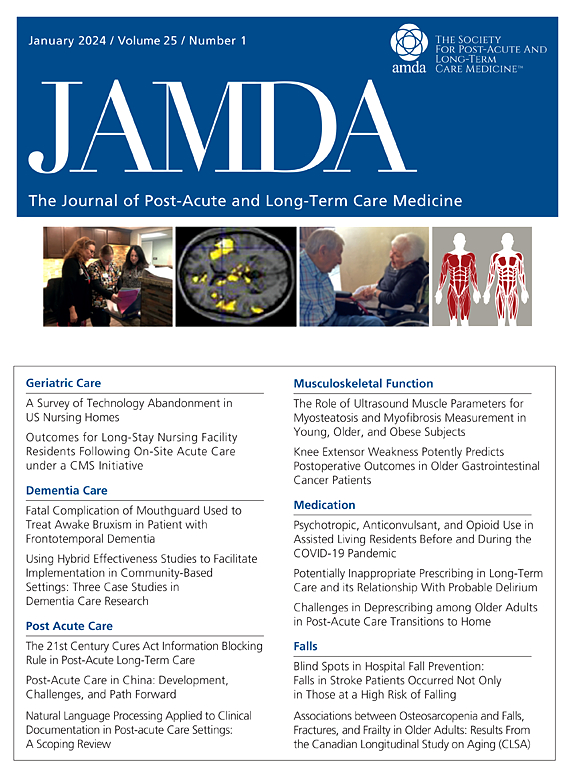Microstructural Brain Changes Associated With Frailty in Older Adults: Insights From Diffusion Tensor Imaging
IF 4.2
2区 医学
Q2 GERIATRICS & GERONTOLOGY
Journal of the American Medical Directors Association
Pub Date : 2025-07-24
DOI:10.1016/j.jamda.2025.105738
引用次数: 0
Abstract
Objectives
This study investigates the relationship between frailty status and white matter integrity (WMI) in older adults, focusing on associations with frailty status.
Design
A cross-sectional study.
Setting and Participants
125 older adults aged ≥65 years without dementia were included.
Methods
A comprehensive geriatric assessment was conducted. Frailty status was evaluated by Fried Frailty criteria: unintentional weight loss, exhaustion, low levels of activity, weakness, and slowness: 0 for nonfrail, 1 to 2 for prefrail, and 3 to 5 for frail. Brain magnetic resonance imaging with diffusion tensor imaging (DTI) was performed, and mean diffusivity, fractional anisotropy, axial diffusivity, and radial diffusivity values were calculated in white matter integrity using a region of interest–based method. Multinomial logistic regression analyzed the multivariate effects of clinical variables on the frailty-WMI association, whereas canonical correlation analysis examined multivariate relationships between diffusion tensor imaging measurements and geriatric assessment parameters.
Results
The mean age was 81.76 ± 7.07 years, and 64% were female. Of the participants, 55.2% were frail, 33.6% prefrail, and 11.2% nonfrail. After adjusting for age and sex, WMI impairment varied in the cingulum, inferior longitudinal fasciculus, and forceps major in the left hemisphere among frailty statuses. Regression analysis showed demyelination of the left cingulum [odds ratio (OR) 0.97, 95% CI 0.95-0.99] and left forceps major (OR 0.99, 95% CI 0.98-0.99) was linked to increased frailty risk. For the frail group, DTI variables and malnutrition were significant. An increase in malnutrition status or risk raised the risk of frailty by 18.86 times. Canonical correlation analysis identified the Lawton-Brody IADL and Epworth Sleepiness Scale scores as the strongest predictors, whereas the cingulum showed the highest association among white matter tracts.
Conclusions and Implications
Frailty and prefrailty were associated with deteriorated WMI, particularly in the left cingulum and left forceps major. The strong link between frailty and WMI may reflect shared underlying mechanisms, including sleep, functionality, and nutrition. Therefore, a multidimensional approach to frailty is important.
与老年人虚弱相关的大脑微结构变化:来自弥散张量成像的见解。
目的:本研究探讨老年人虚弱状态与白质完整性(WMI)之间的关系,重点关注与虚弱状态的关联。设计:横断面研究。环境和参与者:纳入125名年龄≥65岁且无痴呆的老年人。方法:进行全面的老年病学评估。虚弱状态由弗里德虚弱标准评估:非故意体重减轻、疲惫、低水平活动、虚弱和行动迟缓:0为非虚弱,1至2为虚弱前期,3至5为虚弱。使用弥散张量成像(DTI)进行脑磁共振成像,并使用基于兴趣区域的方法计算白质完整性的平均扩散系数、分数各向异性、轴向扩散系数和径向扩散系数值。多项逻辑回归分析了临床变量对虚弱- wmi关联的多变量影响,而典型相关分析检查了弥散张量成像测量与老年评估参数之间的多变量关系。结果:平均年龄81.76±7.07岁,女性占64%。在参与者中,55.2%体弱,33.6%体弱,11.2%非体弱。在调整了年龄和性别后,在虚弱状态下,WMI损伤在左半球的扣带、下纵束和大钳中有所不同。回归分析显示,左侧扣带脱髓鞘[比值比(OR) 0.97, 95% CI 0.95-0.99]和左侧大产钳(OR 0.99, 95% CI 0.98-0.99)与衰弱风险增加有关。对于虚弱组,DTI变量和营养不良是显著的。营养不良状况或风险的增加会使身体虚弱的风险增加18.86倍。典型相关分析发现劳顿-布罗迪IADL和爱普沃斯嗜睡量表得分是最强的预测因子,而扣带在白质束之间的相关性最高。结论和意义:虚弱和脆弱与WMI恶化有关,特别是在左扣带和左产钳。虚弱和WMI之间的紧密联系可能反映了共同的潜在机制,包括睡眠、功能和营养。因此,对脆弱采取多维方法是很重要的。
本文章由计算机程序翻译,如有差异,请以英文原文为准。
求助全文
约1分钟内获得全文
求助全文
来源期刊
CiteScore
11.10
自引率
6.60%
发文量
472
审稿时长
44 days
期刊介绍:
JAMDA, the official journal of AMDA - The Society for Post-Acute and Long-Term Care Medicine, is a leading peer-reviewed publication that offers practical information and research geared towards healthcare professionals in the post-acute and long-term care fields. It is also a valuable resource for policy-makers, organizational leaders, educators, and advocates.
The journal provides essential information for various healthcare professionals such as medical directors, attending physicians, nurses, consultant pharmacists, geriatric psychiatrists, nurse practitioners, physician assistants, physical and occupational therapists, social workers, and others involved in providing, overseeing, and promoting quality

 求助内容:
求助内容: 应助结果提醒方式:
应助结果提醒方式:


